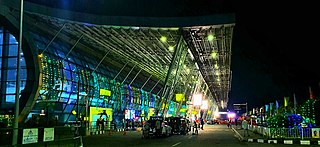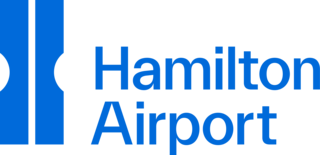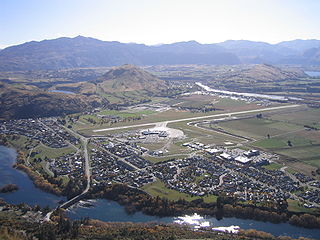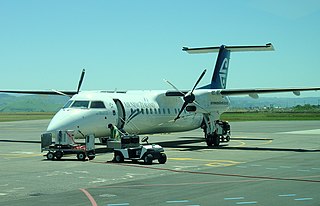Related Research Articles
After the September 11 attacks, there was an immediate call to action regarding the state of aviation security measures as the hijackers involved in 9/11 were able to successfully pass through security and take command of the plane. The existing security measures flagged more than half of the 19 hijackers in 9/11; however, they were cleared to board the plane because their bags were not found to contain any explosives. In the months and years following September 11, 2001, security at many airports worldwide were reformed to deter similar terrorist plots.

The Transportation Security Administration (TSA) is an agency of the United States Department of Homeland Security (DHS) that has authority over the security of transportation systems within, and connecting to the United States. It was created as a response to the September 11 attacks to improve airport security procedures and consolidate air travel security under a dedicated federal administrative law agency.

Auckland Airport is the largest and busiest airport in New Zealand, with over 16 million passengers in the year ended August 2023. The airport is located near Māngere, a residential suburb, and Airport Oaks, a service-hub suburb 21 kilometres (13 mi) south of the Auckland city centre. It is a domestic and international hub for Air New Zealand, and the New Zealand hub of Jetstar.

Airport security includes the techniques and methods used in an attempt to protect passengers, staff, aircraft, and airport property from malicious harm, crime, terrorism, and other threats.

Thiruvananthapuram International Airport, is an international airport that serves Thiruvananthapuram, the capital city of Kerala, India. Established in 1932, it is the first airport in the state of Kerala and the fifth international airport of India, officially declared in 1991. It is the operating base of Air India, Air India Express, IndiGo and SpiceJet. Spread over an area of 700 acres (280 ha), the airport is approximately 3.7 km (2.3 mi) due west from the city centre and the Padmanabhaswamy Temple, 16 km (9.9 mi) from Kovalam beach, 13 km (8.1 mi) from Technopark and 21 km (13 mi) from the under-construction Vizhinjam International Seaport. It shares a visible proximity to Shankumugham Beach making it the nearest airport to the sea in India, just about 0.6 miles away from the sea.

Christchurch Airport is the main airport that serves Christchurch, New Zealand. It is located 12 kilometres (7.5 mi) to the northwest of the city centre, in the suburb of Harewood. Christchurch (Harewood) Airport officially opened on 18 May 1940 and became New Zealand's first international airport on 16 December 1950. It is the second busiest airport in New Zealand, after Auckland and before Wellington by annual passengers, and the second busiest, after Auckland, by aircraft movements.

Wellington International Airport is an international airport located in the suburb of Rongotai in Wellington. It lies 3 NM or 5.5 km south-east from the city centre. It is a hub for Air New Zealand and Sounds Air. Wellington International Airport Limited, a joint venture between Infratil and the Wellington City Council, operates the airport. Wellington is the third busiest airport in New Zealand after Auckland and Christchurch, handling a total of 3,455,858 passengers in the year ending June 2022, and the third busiest in terms of aircraft movements. The airport, in addition to linking many New Zealand destinations with national and regional carriers, also has links to major cities in eastern Australia. It is the home of some smaller general aviation businesses, including the Wellington Aero Club, which operates from the general aviation area on the western side of the runway.

Hamilton Airport is an airport located 14 kilometres south of the city of Hamilton in the Waikato region, in New Zealand. It is sited at Rukuhia, which was the name of the Royal New Zealand Air Force base on that site during World War II.

Whangārei Airport is an airport 4 nautical miles to the south east of Whangārei city, in the suburb of Onerahi, on the east coast of Northland in the North Island of New Zealand. The airport has a single terminal with two gates.
Air National was an airline based in Auckland, New Zealand. It operated domestic and international charter services and scheduled passenger services for Air New Zealand Link. Its main bases were Auckland International Airport

The Canadian Air Transport Security Authority is the Canadian Crown Corporation responsible for security screening of people and baggage and the administration of identity cards at the 89 designated airports in Canada. CATSA responds to Transport Canada and reports to the Government of Canada through the Minister of Transport.

Barrier Air is a New Zealand airline that was established in 1983 by Jim Bergman as Great Barrier Airlines. The head office is located at the Domestic Terminal at Auckland Airport in Māngere, with additional offices in the terminal buildings at Great Barrier Aerodrome, Kaitaia Airport and North Shore Aerodrome.

Queenstown International Airport is an international airport located in Frankton, Otago, New Zealand, which serves the resort town of Queenstown. The airport handled 2.25 million passengers as of 2018 making it the fourth busiest airport in New Zealand by passenger traffic. The airport is known for its scenery and challenging approach to land due to the nearby high terrain.

Hawke's Bay Airport, commonly referred to as Napier Airport, is Hawke's Bay's main commercial airport, serving domestic flights to the main centres of Auckland, Wellington and Christchurch, and smaller centres such as Gisborne. The airport is 5.8 km from Napier and 20.7 km from Hastings.

Chania International Airport "Daskalogiannis" is an international airport located near Souda Bay on the Akrotiri peninsula of the Greek island of Crete, serving the city of Chania, 14 kilometres (8.7 mi) away. It is a gateway to western Crete for an increasing number of tourists. The airport is named after Daskalogiannis, a Cretan rebel against Ottoman rule in the 18th century and is a joint civil–military airport. It is the sixth busiest airport in Greece.
Dehradun Airport, also known as Jolly Grant Airport, is a domestic airport serving Dehradun, the capital of Uttarakhand, India, located 25 km south of the city. Commercial operations began on 30 March 2008, after a runway extension to accommodate larger aircraft. A new terminal building was inaugurated in February 2009. The current passenger terminal was inaugurated in October 2021. Located 20 km (12 mi) from Rishikesh, and 35 km (22 mi) from Haridwar, the airport Dehradun Airport is the 30th busiest airport in India, with over 1 million annual passengers.

Sunair is an airline based in New Zealand.

Originair is an airline based in Nelson, New Zealand, that operates domestic flights in New Zealand. It was founded in 2015 by local businessman Robert Inglis, who had previously founded Air Nelson and Origin Pacific Airways. Originair commenced operations on 12 August 2015 with flights between Nelson and Palmerston North; it started flights between Nelson and Wellington the following month. The airline began its operations with one British Aerospace Jetstream 31 aircraft, and now operates a fleet of four aircraft, following the addition of another 2 Jetstream 32 aircraft.

Civil aviation in India, the world's third-largest civil aviation market as of 2020, traces its origin back to 1911, when the first commercial civil aviation flight took off from a polo ground in Allahabad carrying mail across the Yamuna river to Naini.
References
- 1 2 "Briefing to the Incoming Minister: Civil Aviation Authority" (PDF). Beehive.govt.nz. 14 December 2020. Retrieved 11 September 2023.
- 1 2 "History of aviation security in New Zealand | aviation.govt.nz". www.aviation.govt.nz. Retrieved 11 September 2023.
- ↑ "Briefing to the Incoming Minister: Civil Aviation Authority" (PDF). Beehive.govt.nz. pp. 38, 42. Retrieved 11 September 2023.
- ↑ "Contact us | aviation.govt.nz". www.aviation.govt.nz. Retrieved 2 December 2023.
- ↑ Civil Aviation Authority (2023). "Briefing to the Incoming Minister" (PDF). aviation.govt.nz. Retrieved 2 December 2023.
- 1 2 "Aviation Security Service: Avsec's Role". 27 January 2018. Archived from the original on 27 January 2018. Retrieved 11 September 2023.
{{cite web}}: CS1 maint: bot: original URL status unknown (link) - ↑ "Security screening and other airport duties | aviation.govt.nz". www.aviation.govt.nz. Retrieved 14 December 2023.
- ↑ Granville, Alan (29 August 2023). "Why do I seem to set alarms off in one airport and not the other?". Stuff. Retrieved 14 December 2023.
- ↑ McNeilly, Hamish (12 August 2019). "First full body scanners for Kiwi domestic travellers open at Dunedin Airport". Stuff. Retrieved 14 December 2023.
- ↑ Sabin, Brook (7 December 2022). "Body scanners and boots off: Why is domestic aviation security ramping up?". Stuff. Retrieved 14 December 2023.
- ↑ Sabin, Brook (14 December 2022). "Hundreds of criminals stopped at Auckland Airport by new officers who watch for suspicious passengers". Stuff. Retrieved 14 December 2023.
- ↑ Cornish, Sophie (7 February 2020). "New Chch Airport security to watch for signs of unusual behaviour". Otago Daily Times Online News. Retrieved 14 December 2023.
- ↑ "Behavioural detection | aviation.govt.nz". www.aviation.govt.nz. Retrieved 14 December 2023.